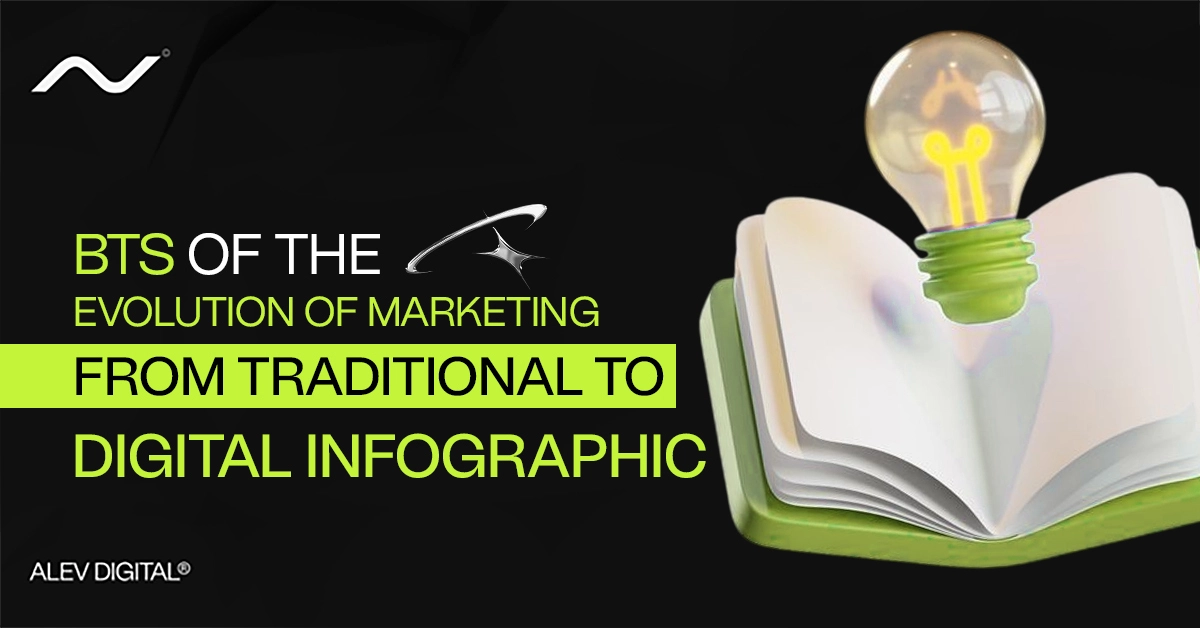There has been a massive change in how content is presented now. Marketing infographics had been pretty in, but nowadays, how they look is another reason competition is fierce. The evolution of marketing from traditional to digital infographics shows that they have notably altered how people consume content. The digital footprint infographic has set the bar high!
Infographic marketing is all about making dull content appear funky and engaging. They are the interactive elements of content, and their visual designs break down complex information into manageable and digestible formats to help readers understand better.
Now, we know that this evolution is not without intent, and marketing infographics satiate the growing need for quick and clear information. What lead to this evolution? Why do marketers suddenly decide to focus on infographic marketing, and is it better than previous marketing content formats?
What Are Traditional Marketing Infographics?
Thinking of modern infographics, it will sound a bit funnier to you how they looked like. Traditional infographic marketing offers visual content that cannot be presented digitally. Think about getting real estate brochures that feature visual elements like statistics, prices, and images. This is an example of traditional infographics. If we ever received one such, we would either not see it twice or just bury it under piles of papers. They used to be printed materials like pamphlets and posters that creatively showcase complex information for readers, typically in static formats. Marketers relied on traditional marketing infographics because these were tried and tested methods to reach local audiences, and the oldest player in the game knows the most about the audience.
While traditional marketing infographics have had their moment of highlight, they lacked precise targeting, relied on one-way communication, and provided limited metrics to measure campaign effectiveness. There’s a gap to be filled for better ways to present information, leading to the emerging era of digital marketing infographics. These newer formats allow for more targeted messaging and enable interactive elements and analytics, enhancing overall engagement and measurement of success. The user behavior is much to blame for a growing need to bring more interactive solutions to the market.
What Is A Digital Infographic?
Traditional infographics have ruled for decades, but imagine reading a brochure every day to track some static analytics for 7 days to make sense of it. No real-time update, nothing new; it all feels like a trap. No one really wants to read through 10 pages of text; wouldn’t it be better if that were turned into a visual or an image? It would get a lot easier!
We began to see little graphics on social media presenting more visually appealing information. These are called digital marketing infographics. Social media has grown into a significant way to share content. Marketing infographics tend to do great on social platforms, too, because people have less time and shorter attention spans but look for value-driven content.
These marketing infographics gained massive popularity due to audience preferences and the promise of desirable results. Unlike traditional infographics, they are presented in visual formats on digital platforms. They transform complex pieces of content simplistically and quickly for readers by offering innovative ways for you to engage with your target audience.
How Do Traditional And Digital Marketing Infographics Differ, And Which Is Better?
It is not us who believe solely, but according to Forbes, 40% of marketers highlight the importance of visual designs or infographics. So, it is safe to say that when done right, marketing infographics make your content more digestible and boost website traffic. But which method works best?
Infographics designed through traditional methods focus more on fixed designs, such as printed materials like posters, brochures, and pamphlets, focusing on static visuals to present information in a visual design. These are confined to limited audiences only, so they perform better. In contrast to this, digital marketing infographics leverage interactive elements and multimedia, engaging audiences through dynamic content.
Traditional ones perform better, but not better, than social media marketing infographics. Traditional infographics usually perform better in local proximities, such as when targeting a local audience. However, digital marketing infographics can engage a worldwide audience and reach more globally. The more people they get, the better it is.
Digital marketing infographics can bring a more appealing factor to the content by including interactive visual elements, like animations. At the same time, infographics based on traditional methods are more fixed and lack such interactivity.
Digital infographics ensure you can better track who has seen your content and where via analytics platforms such as Google Analytics, allowing you to assess performance and audience interaction. Traditional infographics do not enable real-time tracking. They usually have higher printing and distributing costs, making them an expensive choice. In contrast, social media marketing infographics or content marketing infographics can be created and distributed at a much lower cost and with a global reach.
Investing In Digital Marketing Infographics For SEO Gains
Investing in digital marketing infographics might be wise for small businesses and marketers. An infographic on emerging tech is a way to make complex content seem more visually appealing and lead to better outcomes for your SEO efforts. Infographic marketing can change the game for small businesses or marketers trying to rank their content in Google’s search engines. When used correctly, marketing infographics attract backlinks, boost customer engagement and trust, and bring more visitors to your website, increasing website traffic. Plus, search engines love content that gets passed on, and infographics tend to be shared on digital platforms.
Small businesses and new marketers can make their content easier to find and more relevant in Google search results by putting some effort into creating digital marketing infographics. It’s no lie that infographics play a crucial role in making a piece of content go from zero to a hundred quickly. According to Forbes, in 2018, 63.5% of surveyed companies said that “between 75 and 100% of their content contained visuals.” highlighting the immense need for infographics in their content. Only one year later, 74% of companies now rely on visual data marketing. That results in an increase of 10.5%! Digital marketing infographics, in comparison to traditional means, can keep readers on your website for a longer time, improving and enhancing your site’s SEO performance. Your content can perform better in search engines!
What Makes Alev The Best Choice For Infographic Marketing?
Infographic marketing is all about industry trends and being a thought leader to lead such trends. Setting new trends should be the aim rather than following the current trends. So, it is always the best time to switch to the viral practices.
As time changes, so does the need to advance your marketing efforts, or else your content might not perform as well as your competitors’. Businesses are now shifting towards a more digital-centric approach to visual content. Going for digital marketing infographics can ensure you can keep up with the changing trends. Alev Digital ensures your efforts aren’t wasted when selecting the proper infographic marketing.
Frequently Asked Questions
Digital marketing infographics are visual elements that make content pieces stand out. An Infographic on emerging tech is essential because it enhances readability and boosts customer engagement.
Infographic marketing is a critical way to improve SEO. Increasing content performance overall. By using social media marketing infographics, you can enhance the SEO performance of your content and reach a wider audience.
Investing in digital infographics over traditional methods can give your content a better chance at ranking well in search engines like Google. A digital footprint infographic attracts more readers and more visitors to your site.
Yes, investing in infographic marketing, whether a digital footprint infographic, social media marketing infographic, or content marketing infographic, can be very beneficial for your small business, as visual designs like digital infographics can increase readability.
Yes, at Alev Digital, we have a team of experts who ensure your content’s visibility can increase with the best quality and well-designed infographics, leading to more website traffic and higher SEO rankings.





